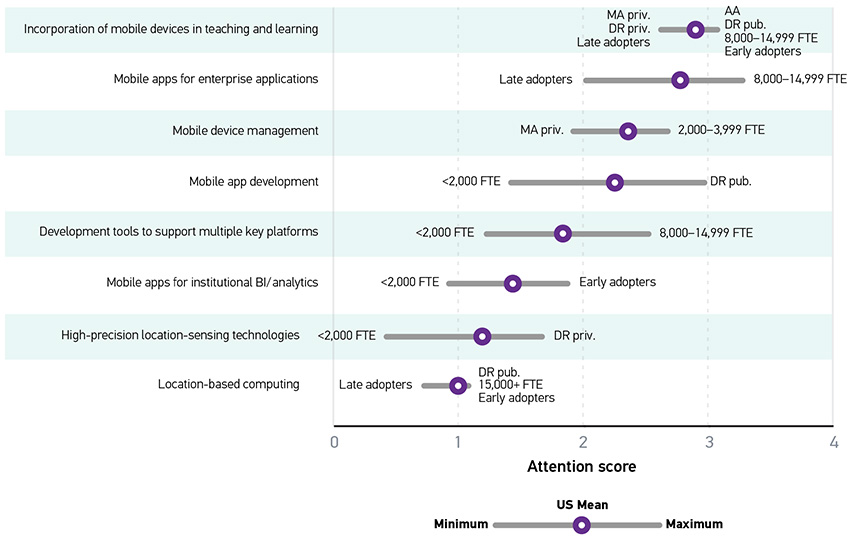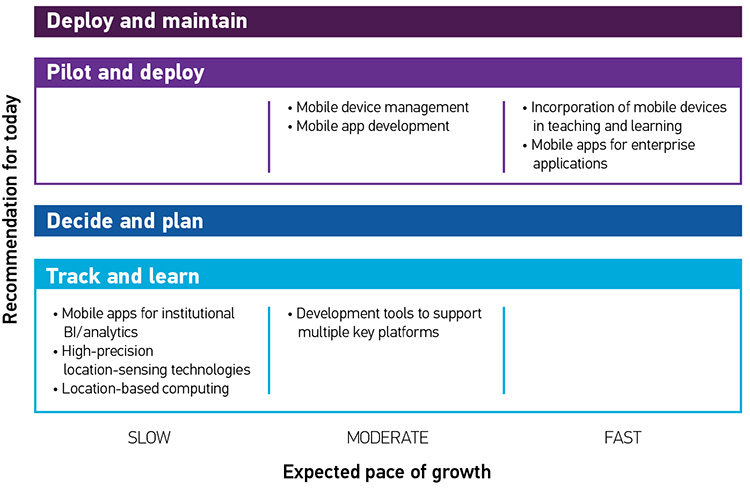Mobile
By now, it is a well-known fact that the smartphones we carry in our pockets, purses, and briefcases have exponentially more computing power than the guidance computers for the NASA Apollo missions that put men on the moon. More than 10 years after the introduction of the first iPhone, nearly every student has a smartphone and/or a tablet (98%) and nearly every faculty member has access to a smartphone and/or tablet (96%). Furthermore, students are using these devices for nearly all of their courses and are increasingly seeing them as important to their academic success. The rapid adoption of these technologies by nearly all of IT's most important end users contributes to the centrality of these devices to their work and may explain why two of the Top 10 Strategic Technologies for 2018 are related to mobile technologies. Indeed, the importance of mobile straddles both the academic (#3: "incorporation of mobile devices in teaching and learning") and business (#4: "mobile apps for enterprise applications") sides of house, rendering it important across all domains and missions of the institution.
This section covers the three trends and eight technologies included in the mobile domain. The prioritization of trends related to this domain reflects an attempt to organize the issues that have emerged in relation to mobile technologies in a logical, sequential manner. While the deployment of technologies to support mobile may lag the adoption of the devices themselves, the piloting and deployment of mobile apps (especially for enterprise applications), the management of mobile devices, and the development of pedagogically sound approaches to incorporating mobile devices in teaching and learning may allow us to finally and boldly go where no one has gone before.
Trends
Included in this domain:
- Contributions of IT to institutional operational excellence
- Managing mobility (of people, data, institutional resources)
- Ubiquitous digital sources and streams
Understand how the most influential trends are affecting your institution.
One trend is influential at 61% or more of colleges and universities:
- Contributions of IT to institutional operational excellence
Review the trends that are taking hold and address them at your institution.
One trend is influential at 41–60% of institutions:
- Managing mobility (of people, data, institutional resources)
Understand these trends, and consider their possible role at your institution.
The influence of one trend is limited to 21–40% of institutions. Higher education is monitoring this trend with respect to emerging IT strategy and the deployment of mobile strategic technologies:
- Ubiquitous digital sources and streams
Technologies
Included in this domain:
- Development tools to support multiple key platforms
- High-precision location-sensing technologies
- Incorporation of mobile devices in teaching and learning
- Location-based computing
- Mobile app development
- Mobile apps for enterprise applications
- Mobile apps for institutional BI/analytics
- Mobile device management
Complete initial deployment and maintain these technologies.
Our research shows that most institutions are not ready to deploy these mobile strategic technologies. Consider initial deployment only if one of these technologies is essential to your mobile strategy.
Pilot and start deploying these technologies.
At this time, about one-half to two-thirds of institutions are planning to pilot and deploy these four mobile strategic technologies (listed below from highest to lowest attention):
- Incorporation of mobile devices in teaching and learning
- Mobile apps for enterprise applications
- Mobile device management
- Mobile app development
Decide when these technologies fit your strategy, and start planning.
Our research shows that mobile strategic technologies are currently outside the deciding/planning stage for most institutions.
Learn about and track these technologies.
A majority of institutions are tracking and learning about the following four mobile strategic technologies (listed below from highest to lowest attention):
- Development tools to support multiple key platforms
- Mobile apps for institutional BI/analytics
- High-precision location-sensing technologies
- Location-based computing
Peer Institution Approach to Strategic Technologies
Understanding what peer institutions (both current and aspirational) are doing can help you gauge whether your institution's current approach is on track or might warrant reconsideration. Some technologies are more relevant for some types of institutions than others. We looked at broad demographic categories, including Carnegie class, institutional size, and approach to technology adoption and found differences in attention score based on those factors. (See the methodology section for explanation of our attention score calculation.) In figure 7, the US mean is the average attention score for an item from all US respondents. The minimums and maximums are the lowest and highest average attention scores among all groups within the categories of Carnegie class, institution size, and timing of technology adoption, with labels indicating which group or groups returned that score. In the event of a tie, all tied groups are represented.

Preparing for the Future
Understanding the technologies that are most relevant for your institution and how fast a certain strategic technology may be growing is critical to institutional IT strategy. We estimated the pace of growth based on the percentage of institutions we predict will implement each technology over the next five years (by 2023). Figure 8 positions each technology in one of 12 cells based on institutional intentions (the "recommendation for today") and the expected pace of growth of that technology. Reflecting what was noted above, the figure shows that half of the technologies we tracked are still being explored—rather than deployed—by most institutions.
